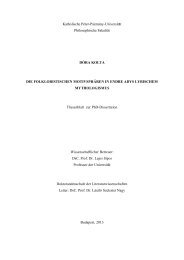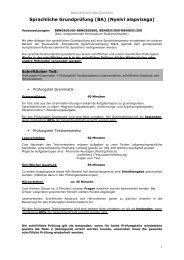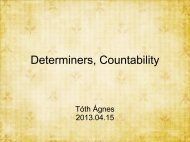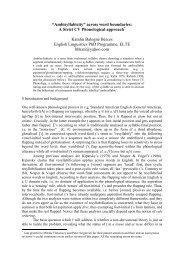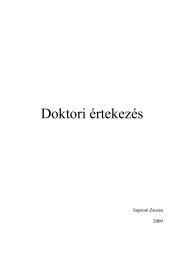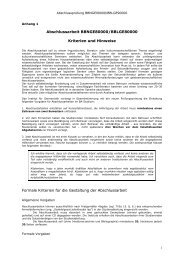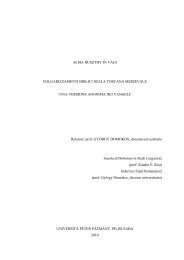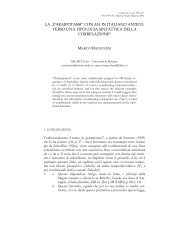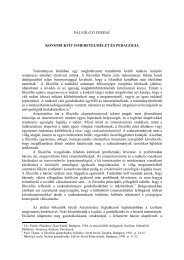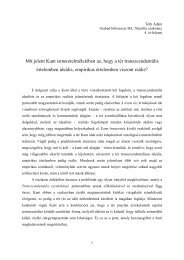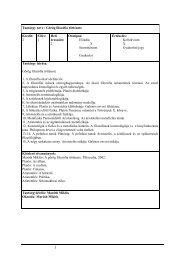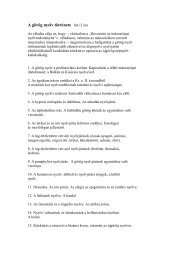Pázmány Péter Katolikus Egyetem • Mini-course • 11–12 January ...
Pázmány Péter Katolikus Egyetem • Mini-course • 11–12 January ...
Pázmány Péter Katolikus Egyetem • Mini-course • 11–12 January ...
Create successful ePaper yourself
Turn your PDF publications into a flip-book with our unique Google optimized e-Paper software.
Marcel den Dikken — <strong>Pázmány</strong> <strong>Péter</strong> <strong>Katolikus</strong> <strong>Egyetem</strong> — <strong>Mini</strong>-<strong>course</strong> 2013 — The syntax of adpositional phrases<br />
8<br />
<br />
<br />
<br />
<br />
<br />
the judgements for (25a) and (25c) are clear: the former is perfect, and the latter is good only with<br />
focus on the FQ, as previously<br />
my judgement for (25b) is not perfectly crisp, but it strikes me as acceptable<br />
[(25d) sounds pretty horrid, but it is hard to say whether this is due to grammatical or extragrammatical<br />
causes (so I leave the diacritic for this sentence undecided): (25d) really is pushing the limit;<br />
it is virtually impossible to find a context that would justify the use of two FQs]<br />
this suggests that there is a subject-of-predication inside the locative portion of a complex directional<br />
PP<br />
it is the directional xPP that is predicated of de vliegtuigen; the locative portion of the directional<br />
xPP is not (directly) predicated of de vliegtuigen<br />
so we have two subjects of predication, and we also need a structural subject position inside the<br />
locative portion of the structure, in order to make it possible for the subject to raise and license a FQ<br />
(26) [ er [C [ t [Dx [ allebei t [RELATOR [ [tien meter lang [Asp [ langs<br />
[ t [C [ PRO [Dx [ allebei t [RELATOR [ [tien meter hoog [Asp [ boven<br />
[DIR] [DIR] [DIR]<br />
CP DxP SU RP SU AspP PP<br />
[LOC] [LOC] [LOC]<br />
CP er DxP RP PRO<br />
AspP PP<br />
NB<br />
though a FQ cannot be locally associated to PRO, it can of <strong>course</strong> perfectly well be associated to the<br />
trace of PRO: (10b,c) both have grammatical variants with all to the right of to<br />
<strong>•</strong> the FQ facts have thus led us to the conclusion that a complex directional circumPP such as (24) is<br />
internally a control structure — effectively just the same as what we have in, say, (27)<br />
(27) the children both tried [PRO to both be successful]<br />
<br />
this result, if it holds up to further scrutiny, solidifies the parallel between xPPs and xVPs, and justifies<br />
Den Dikken’s (2010) decision to relabel Koopman’s functional projections as AspP and DxP<br />
<strong>•</strong> at least two empirical questions remain<br />
Q1 how to deal with word orders in which the FQ appears in front of the r-pronoun, as in (28)?<br />
?<br />
(28) [allemaal er pal boven op] lagen de boeken<br />
all there right up on lie the books<br />
<br />
er could potentially be in a lower position here, in particular, SpecAspP (cf. Koopman’s SpecPlaceP)<br />
Q2 how to deal with the difference between definite er and indefinite ergens in (29)?<br />
(29) a. [er allemaal pal boven op] liggen de boeken<br />
there all right up on lie the books<br />
b. [ergens allemaal pal boven op] liggen de boeken<br />
somewhere all right up on lie the books<br />
b. [allemaal ergens pal boven op] liggen de boeken<br />
<br />
<br />
<br />
while (29b) is grammatical, it forces a [+specific] reading onto indefinite ergens; for a non-specific<br />
reading, (29b) must be used<br />
this is probably merely a matter of scope (relative to the universal FQ), but it may be indicative of<br />
something more profound<br />
the difference between er and ergens is relevant also in the context of the discussion of P-doubling<br />
in Flemish



